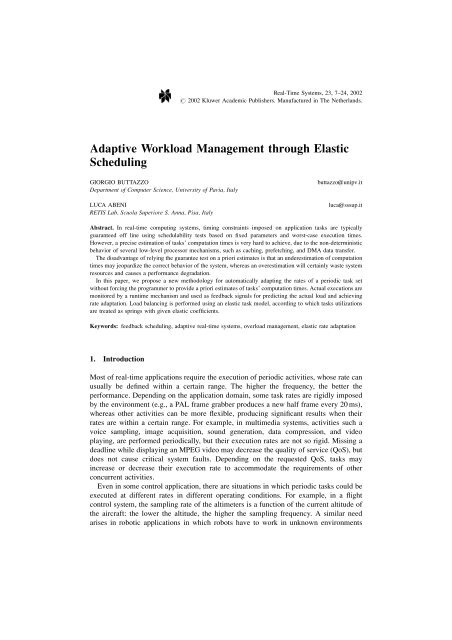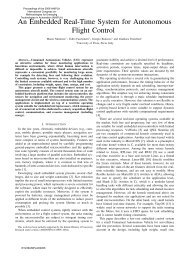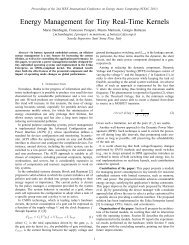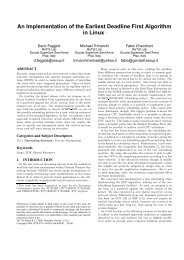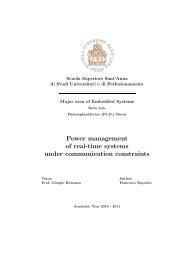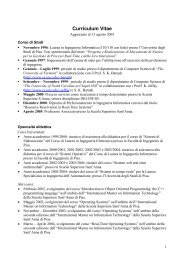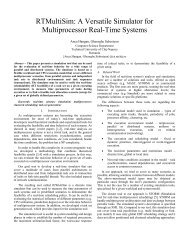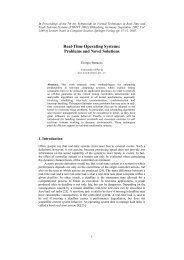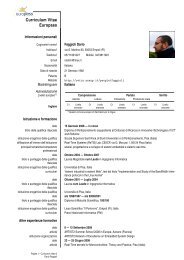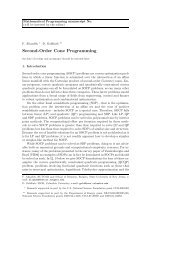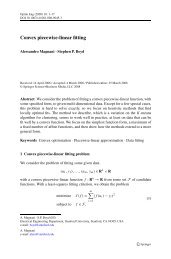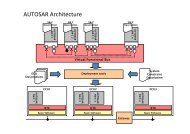Adaptive Workload Management through Elastic ... - ReTiS Lab
Adaptive Workload Management through Elastic ... - ReTiS Lab
Adaptive Workload Management through Elastic ... - ReTiS Lab
You also want an ePaper? Increase the reach of your titles
YUMPU automatically turns print PDFs into web optimized ePapers that Google loves.
Real-Time Systems, 23, 7±24, 2002# 2002 Kluwer Academic Publishers. Manufactured in The Netherlands.<strong>Adaptive</strong> <strong>Workload</strong> <strong>Management</strong> <strong>through</strong> <strong>Elastic</strong>SchedulingGIORGIO BUTTAZZODepartment of Computer Science, University of Pavia, ItalyLUCA ABENIRETIS <strong>Lab</strong>, Scuola Superiore S. Anna, Pisa, Italybuttazzo@unipv.itluca@sssup.itAbstract. In real-time computing systems, timing constraints imposed on application tasks are typicallyguaranteed off line using schedulability tests based on ®xed parameters and worst-case execution times.However, a precise estimation of tasks' computation times is very hard to achieve, due to the non-deterministicbehavior of several low-level processor mechanisms, such as caching, prefetching, and DMA data transfer.The disadvantage of relying the guarantee test on a priori estimates is that an underestimation of computationtimes may jeopardize the correct behavior of the system, whereas anoverestimationwill certainly waste systemresources and causes a performance degradation.In this paper, we propose a new methodology for automatically adapting the rates of a periodic task setwithout forcing the programmer to provide a priori estimates of tasks' computation times. Actual executions aremonitored by a runtime mechanism and used as feedback signals for predicting the actual load and achievingrate adaptation. Load balancing is performed using an elastic task model, according to which tasks utilizationsare treated as springs with given elastic coef®cients.Keywords: feedback scheduling, adaptive real-time systems, overload management, elastic rate adaptation1. IntroductionMost of real-time applications require the execution of periodic activities, whose rate canusually be de®ned within a certain range. The higher the frequency, the better theperformance. Depending on the application domain, some task rates are rigidly imposedby the environment (e.g., a PAL frame grabber produces a new half frame every 20 ms),whereas other activities can be more ¯exible, producing signi®cant results when theirrates are withina certainrange. For example, inmultimedia systems, activities such avoice sampling, image acquisition, sound generation, data compression, and videoplaying, are performed periodically, but their execution rates are not so rigid. Missing adeadline while displaying an MPEG video may decrease the quality of service (QoS), butdoes not cause critical system faults. Depending on the requested QoS, tasks mayincrease or decrease their execution rate to accommodate the requirements of otherconcurrent activities.Even in some control application, there are situations in which periodic tasks could beexecuted at different rates in different operating conditions. For example, in a ¯ightcontrol system, the sampling rate of the altimeters is a function of the current altitude ofthe aircraft: the lower the altitude, the higher the sampling frequency. A similar needarises in robotic applications in which robots have to work in unknown environments
10 BUTTAZZO AND ABENIa frame grabber) should have E i ˆ 0. Other periodic computations whose rate is notrigidly determined by the hardware could have some elasticity. For instance, in a robotcontrol application, trajectory planning would have a higher elasticity than obstacleavoidance, which in turn would be more elastic than force control. We recall that theelastic coef®cient only determines how the task period is varied within its range.Also notice that the elastic task model automatically solves an optimal task frequencyassignment for tasks whose control performance can be described by a quadratic costfunction with respect to the sampling frequency (a spring system naturally minimizes theelastic potential energy, which is proportional to the square of the displacements).According to this approach, the elastic coef®cients can be used to express a proper costfunction.Inthe following, T i will denote the actual period of task t i , which is constrained to beinthe range ‰T i0; T imaxŠ, whereas C i will denote its actual exectution time (considered to beunknown a priori). Inthe case of tasks with variable computationtimes, C i will denotethe actual worst-case executiontime. Any period variation, is always subject to anelasticguarantee and is accepted only if there exists a feasible schedule in which all the otherperiods are withintheir range. Inour framework, tasks are scheduled by the EarliestDeadline First algorithm [13]. Hence, if P …C ubi =T i0†1, all tasks canbe created at theminimum period T i0, otherwise the elastic algorithm is used to adapt the tasks' periods toT i such that P …C i =T i †ˆU d 1, where C i is the actual on-line execution estimate andU d is some desired utilizationfactor. It caneasily beenshown(see Section3.2) that asolutioncanalways be found if P …C ubi =T imax†1.With respect to the classical elastic approach described inButtazzo et al. (1998), inthispaper we assume that tasks' actual computation times are not known a priori, but areestimated at run time by a monitoring mechanism built in the kernel, able to record theactual execution time of each task instance. Such a monitoring mechanism is available onthe HARTIK kernel, where the adaptive elastic approach has been implemented andtested Abeni and Buttazzo (2000). As demonstrated in Section 5, the on-line estimationmechanism can effectively be applied to tasks with ®xed computation times which are notknown a priori, as well as to tasks whose computation times vary signi®cantly frominstance to instance.Since the estimated values of the execution times can change during programexecution, the rate adaptation algorithm is periodically executed. The estimatedexecutiontimes canbe considered as a feedback to adapt the system load. Inoverloadconditions, they are used to keep the number of missed deadlines as low as possible,whereas in underload conditions … P …C i =T i † 5 1† the ef®ciency of the system isincreased to utilize the processor up to a desired value U d .3. Task Compression AlgorithmFor the sake of completeness, in this section, we will brie¯y recall the compressionalgorithm presented in Buttazzo et al. (1998). For a more general description of the elasticapproach see Buttazzo et al. (2002), where the algorithm has also beenextended to beused in the presence of resource constraints. In the next section we will use the
ADAPTIVE WORKLOAD MANAGEMENT THROUGH ELASTIC SCHEDULING 11compression algorithm to automatically ®nd a feasible period con®guration based on theactual tasks' demand, relieving the programmer of estimating the tasks' computationtimes.To understand how an elastic guarantee is performed in this model, it is convenient tocompare anelastic task t i with a linear spring S i characterized by anelastic coef®cient E i ,a nominal length x i0, and a minimum length x imin. Inthe following, x i will denote theactual length of spring S i , which is constrained to be in the range ‰x imin; x i0Š. Inthiscomparison, the length x i of the spring is equivalent to the task's utilization factorU i ˆ C i =T i , hence, a set of n tasks with total utilizationfactor U p ˆ Pni ˆ 1 U i canbeviewed as a sequence of n springs with total length L ˆ Pni ˆ 1 x i.Using the same notation introduced by Liu and Layland (1973), let Ulub A be the leastupper bound of the total utilizationfactor for a givenscheduling algorithm A. We recallthatPfor n tasks Ulub RM ˆ n…21=n 1† and UlubEDF ˆ 1. Moreover, we de®ne U 0 ˆni ˆ 1 C i=T i0and U min ˆ Pni ˆ 1 C i=T imax. Hence, a task set can be schedulable by A atthe nominal rates if U 0 Ulub A . Under EDF, such a schedulability condition becomesnecessary and suf®cient.Under the elastic model, given a scheduling algorithm A and a set of n periodic taskswith U 0 > Ulub A , the objective of the guarantee is to compress tasks' utilization factors inorder to achieve a desired utilization U d Ulub A such that all the periods are withintheirranges. In a linear spring system of total length L 0 ˆ Pni ˆ 1 x i 0, this is equivalent tocompressing the springs by a force F, so that the new total length becomes L d 5 L 0 . Thisconcept is illustrated in Figure 1.In the absence of length constraints (i.e., if x min ˆ 0 ) the length x i of each compressedspring can be computed as follows:Vi x i ˆ x i0…L 0 L d † K pk i…1†Figure 1. A linear spring system: the total length is L 0 when springs are uncompressed (a); and L d 5 L 0 whensprings are compressed (b).
ADAPTIVE WORKLOAD MANAGEMENT THROUGH ELASTIC SCHEDULING 13whereU v0 ˆ Xt i [ GvU i0U f U imint i [ Gfˆ XE v ˆ Xt i [ GvE i…8†…9†…10†If there exist tasks for which U i 5U imin, thenthe period of those tasks has to be ®xed at itsmaximum value T imax(so that U i ˆ U imin), sets G f and G v must be updated (hence, U f andE v recomputed), and Equation (7) applied again to the tasks in G v . If there exists afeasible solution, that is, if the desired utilization U d is greater thanor equal to theminimum possible utilization U min ˆ Pni ˆ 1 …C i=T imax†, the iterative process ends wheneach value computed by Equation (7) is greater than or equal to its correspondingminimum U imin. The algorithm 1 for compressing a set G of n elastic tasks up to a desiredutilization U d is showninFigure 2.3.1. DecompressionAll tasks' utilizations that have been compressed to cope with an overload situation canreturn toward their nominal values when the overload is over. Let G c be the subset ofcompressed tasks (that is, the set of tasks with T i > T i0), let G a be the set of remainingtasks in G (that is, the set of tasks with T i T i0), and let U d be the current processorutilizationof G. Whenever a task in G a decreases its rate or returns to its nominal period,all tasks in G c can expand their utilizations according to their elastic coef®cients, so thatthe processor utilizationis kept at the value of U d .Now, let U c be the total utilizationof G c , let U a be the total utilizationof G a , and letU c0be the total utilizationof tasks inG c at their nominal periods. It can easily be seen thatif U c0‡ U a U lub all tasks in G c can return to their nominal periods. On the other hand,if U c0‡ U a > U lub , thenthe release operationof the tasks inG c canbe viewed as acompression, where G f ˆ G a and G v ˆ G c . Hence, it can still be performed by usingEquations (7), (9) and (10) and the algorithm presented in Figure 2.3.2. Theoretical ResultsThe following theorem states the convergence and the complexity of the elastic approach,and provides a condition under which a feasible solution is always found.
14 BUTTAZZO AND ABENIFigure 2. Algorithm for compressing a set of elastic tasks.THEOREM 1 Given a set G ˆft i …C ubi ; T i ; T imax†ji ˆ 1; ...; ng of elastic tasks, ifX ni ˆ 1C ubiT imax 1 …11†the compression algorithm converges to a feasible solution in O…n 2 † time, in the worstcase.Proof: If inequality (11) holds, the feasibility of the solution is guaranteed because, inthe worst case, task periods canbe extended up to their maximum value T i ˆ T imax,and
ADAPTIVE WORKLOAD MANAGEMENT THROUGH ELASTIC SCHEDULING 15since C ubihaveis anupper bound of the actual worst-case computationtime …C i C ubi † weX n C i XnTi ˆ 1 imax i ˆ 1C ubiT imax 1Moreover, if condition (11) is veri®ed, the convergence of the iterative compressionalgorithm canbe proved as follows. After each compressionstep, two situations mayoccur:1. T i 5T imaxVt i [ G v .2. There exists some k, such that t k [ G v and T k ˆ T kmax.If condition 1 is true, a feasible solution has been found and the algorithm stops. Ifcondition 2 is true, set G v is updated by removing those tasks that reached their maximumperiod and another iteration is performed on the remaining tasks in G v . Every timecondition 2 holds, the set G v is reduced at least by one task. Since G v initially contains ntasks, it follows that the compressionalgorithm will iterate at most for n times. Since,each compressionstep has anO…n† complexity, the complexity of the overallcompressionalgorithm is O…n 2 † inthe worst case.jInButtazzo et al. (2000) it is shownthat, inorder to keep the task set schedulable duringcompression, periods must be changed at opportune instants. In particular, the followingtheorem states a property of compression: if at time t tasks increase their periods from T ito T 0 i , thenfrom a certaintime t* on, the total utilization factor is decreased from U p toU 0 p ˆ Pni ˆ 1 …C i=T 0 i †.THEOREM 2 Let G be a task set with utilization U p and let G c be the subset of tasks thatat time t increase their period, so that the total processor utilization U p is compressedto Up5U 0 p . Let t* ˆ max ti [ G c…d i c i …t†=U i †, where c i …t† is the remaining computationtime of task t i . Then, from time t* on, the bandwidth used by the task set is not greaterthan Up.0The reasonwhy the saved bandwidth U p Up 0 is not available immediately at time t isthat some of the compressed tasks already executed with the previous period, thusconsuming the processor bandwidth originally allocated to them. As a consequence,interval ‰t, t*Š is needed for estinguishing the transient.It is worth noting that in case of decompression (that is, when utilizations are increasedby period reduction), a task cannot reduce its period immediately, but has to wait until itsnext activation.Consider the example shown in Figure 3, where two tasks, with computation timesC 1 ˆ 3andC 2 ˆ 2 and periods T 1 ˆ 10 and T 2 ˆ 3, start at time 0. The processorutilizationis U p ˆ…29=30†, thus the task set is schedulable by EDF. Suppose that, at timet ˆ 14, t 1 wants to change its period from T 1 ˆ 10 to T1 0 ˆ 5, so that the compression
16 BUTTAZZO AND ABENIFigure 3. A task canmiss its deadline if a period is decreased at arbitrary time.algorithm increases the period of t 2 from T 2 ˆ 3 to T2 0 ˆ 6 to keep the systemschedulable. The new processor utilization is Up 0 ˆ…28=30†, so the task set is stillschedulable; however, if periods are changed immediately (i.e., at time t ˆ 14), task t 1misses its deadline at time t ˆ 15.In general, although the periods of the tasks that decrease their rate can be changedimmediately, the periods of the tasks that increase their rate can be changed only at theirnext release time. Thus, when the system receives a request of period variation, itcalculates the new periods according to the elastic model: if the new con®guration isfound to be feasible (i.e., Up51), 0 thenit increases the periods of the decompressed tasksimmediately, but decreases the periods of the compressed tasks only at their next releasetime. Theorem 2 ensures that the total processor demand in any interval ‰t; t ‡ LŠ willnever exceed LU p and no deadline will be missed.4. Online Adaptation AlgorithmThe elastic approach provides a powerful and ¯exible methodology for adapting theperiodic tasks' rates to different workload conditions. The effectiveness of the approach,however, strongly relies on the knowledge of the WCETs. If WCETs are not preciselyestimated, the compression algorithm will lead to wrong period assignment. In particular,if WCETs are underestimated the compressed tasks may start missing deadlines, whereasif WCETs are overestimated, the algorithm will cause a waste of resources, as well as aperformance degradation.This problem has beenaddressed inFujita et al. (1995) and Nakajima (1998) by usinga CPU reservation technique to enforce the maximum execution time per period, to eachtask. With this technique, however, the amount of time reserved to each task in eachperiod must still be de®ned based on some off-line estimation. If the reserved budget istoo small, the task will experience large overruns which cause the algorithm to increaseits period too much. Onthe other hand, if the estimationis too big, the periods are not
ADAPTIVE WORKLOAD MANAGEMENT THROUGH ELASTIC SCHEDULING 17Figure 4. Feedback-based architecture for elastic rate adaptation.optimized, the reserved budget is never used completely, and the system isunderutilized.The solution proposed in this paper uses on-line estimates of tasks' execution times asfeedback for achieving load adaptation. Such estimates are derived by a runtimemonitoring mechanism embedded in the kernel. When a task starts its execution, it iscreated at its minimum rate, and, at the end of each period, a runtime monitoringmechanism updates the mean execution time ^c i and the maximum execution time ^C i .Figure 4 shows the architecture used to perform the rate adaptation. The two values ^C iand ^c i derived by the monitoring kernel mechanism are used to compute an executiontime estimate Q i , used by the load estimator to compute the actual load U a ˆ P…Qi =T i †.Such a value is thenused by the elastic algorithm ( periodically invoked with a period P)to adapt tasks' rates. Thus, the objective of the global control loop is to maintain theestimated actual load U a close to a desired value U d .The advantage of using the elastic compression algorithm is that rate variations can becontrolled individually for each task by means of elastic coef®cients, whose values can beset to be inversely proportional to tasks' importance.Using this approach, the application is adapted to the actual computational power ofthe hardware platform without any a priori knowledge on task computation times. Theeffectiveness of the adaptation depends on whether tasks' utilizations are computed basedonworst-case or average-case estimates. If the ^C i estimate is used to compute tasks'utilizations for the elastic algorithm, tasks are assigned larger periods and the number ofdeadline misses quickly reduces to zero. However, this solution can cause a waste ofresources, since tasks seldom experience their worst case simultaneously.To increase ef®ciency, a more optimistic estimation can be used in order to exploitsystem resources: the resulting approach is a trade off between ``rigid'' reservationsystems (in which each task is assigned a ®xed amount of resources and cannot demandmore, also if the other tasks are requiring less than the reserved amount) and completelyunprotected system, such as bare EDF or RM. In this sense this approach is similar tothe ``bandwidth sharing server'' (BSS) (Lipari et al., 1998), where tasks belonging tothe same applicationcanshare the same resources. Inthe BSS case, however, thefraction of CPU bandwidth that can be exchanged among tasks belonging to a particularapplication cannot be controlled, whereas in the elastic model it depends on the elasticcoef®cients.
18 BUTTAZZO AND ABENIIn order to avoid that the number of deadline misses per time unit increases inde®nitelyto in®nite, the execution time estimate used to perform the elastic compression must begreater thanthe task's meanexecutiontime, so a value between^c i and ^C i is consideredacceptable. Inour model, the elastic compressionalgorithm is invoked using a valueQ i ˆ ^c i ‡ k… ^C i ^c i †where k [ ‰0; 1Š is the guarantee factor. Then, the utilization factor ^U i is computed as^U i ˆ QiT iand the actual load U a is estimated asU a ˆ X ^U iThe guarantee factor k is used to balance predictability versus ef®ciency. If k ˆ 1, theelastic algorithm results to be based on WCET estimations, so only a few deadlines canbe missed whenthe estimated WCET ^C i is smaller than the real one. In general, if noinformation about execution times is provided, the ®rst ^C i values will likely beunderestimated and may cause some deadline miss during task's startup time.Smaller values of k allow increasing the actual system utilization at the cost of a largernumber of possible deadline misses (we recall that a deadline is missed when many tasksrequire a long execution at the same time). A value of k ˆ 0 allows maximum ef®ciencybut is the limit under which the system overload becomes permanent.It is worth noting that the proposed approach can be used both when no a prioriinformation about execution times is provided, and when an approximated estimation ofthe meanor maximum executiontime is know. The method canalso be successfullyapplied to task sets characterized by variable computationtimes, allowing task periods tovary according to execution times variations. In fact, at run time, the mean execution timeestimationis computed iteratively (that is, ^c i is periodically updated based onthe lastexecution time experienced by the task) starting from an initial value c 0 i . If nothing isknown about the task parameters, an arbitrary value is assumed for c 0 i . Onthe other hand,if an approximate estimation of the execution time is known in advance, it can be used asc 0 i , so reducing the initial transient during which ^c i converges to a reasonable estimationand increasing the speed at which periods converge towards a ``stable value''.When the proposed mechanism is applied to tasks characterized by unknown but ®xedexecutiontimes, if a feasible solutionexists, the stable period con®gurationcanbereached without any deadline miss. In this case, since the mean execution time is equal tothe WCET, the guarantee factor must be set to k ˆ 1.5. Experimental ResultsTo test the effectiveness of the adaptation algorithm, the elastic task model has beenimplemented on top of the HARTIK kernel (Buttazzo, 1993; Lamastra et al., 1997), as amiddleware layer. In particular, the elastic guarantee mechanism has been implemented
ADAPTIVE WORKLOAD MANAGEMENT THROUGH ELASTIC SCHEDULING 19as a high priority task, the elastic manager (EM), activated by the other tasks when theyare created or when they want to change their period. Whenever activated, the EMcalculates the new periods and changes them atomically. According to the result ofTheorem 2, periods are changed at the next release time of the task whose period isdecreased. If more tasks ask to decrease their period, the EM will change them, ifpossible, at their next release time.In a ®rst experiment, we tested the behavior of the elastic compression mechanism(without the on-line estimation mechanism) using the task set shown in Table 1. In thiscase, tasks' parameters are assumed to be known a priori, and each task is characterizedby a constant execution time, reported in the C i column. At time t ˆ 0, the ®rst three tasksstart executing at their nominal period, whereas the fourth task starts at timet 1 ˆ 10 seconds, so creating a dynamic workload variation.When t 4 is started, the task set is not schedulable with the current periods, thus the EMtries to accommodate the request of t 4 by increasing the periods of the other tasksaccording to the elastic model. The actual execution rates of the tasks are shown in Figure5. Notice that, although the ®rst three tasks have the same elastic coef®cients and thesame initial utilization, their periods are changed by a different amount, because t 3reaches its maximum period.In a second experiment, we tested the on-line estimation mechanism on a set of taskscharacterized by ®xed execution times, where each task instance was implemented as asimple dummy loop. As previously discussed, by setting k ˆ 1, we veri®ed that theestimation mechanism was able to reach a stable period con®guration in one step, withoutcausing any deadline miss.In the next experiment, we tested the adaptive algorithm in the case of variableexecutiontimes, using four tasks started at time t ˆ 0. Tasks' periods and elastic factorsare the same as the ones used in the ®rst experiment, shown in Table 1, whereas executiontime varies randomly with uniform distribution between 5 and 55 ms. During thisexperiment, we monitored tasks' execution times and measured how the estimated valuesand the number of deadline misses changed as the guarantee factor k varied from 0 to 1.We note that tasks' execution times are assumed to be unknown and a value c 0 i ˆ 5mshas beenused as aninitial estimate for ^c i .Figure 6 shows the estimated executiontime Q 1 (from the jobs of task t 1 ) for differentvalues of the guarantee factor k. We cansee that the value of the guarantee factorin¯uences the stability, the conservativeness and the precision of the estimation. In fact,small values of k cause the estimate to converge around a stationary value after a longTable 1. Task set parameters used for the ®rst experiment. Periods and computation times are expressed inmilliseconds.Task C i T i0T imaxE it 1 30 100 500 1t 2 60 200 500 1t 3 90 300 500 1t 4 24 50 500 0
20 BUTTAZZO AND ABENIFigure 5. Dynamic task activation.Figure 6. Estimated executiontime of task t 1 as a function of the guarantee factor k.
ADAPTIVE WORKLOAD MANAGEMENT THROUGH ELASTIC SCHEDULING 21Figure 7. Missed deadlines per second as a function of the guarantee factor.transient. On the other hand, a high guarantee factor causes the system to beunderutilized.The in¯uence of the guarantee factor on the number of missed deadlines is illustratedin Figure 7, which shows the evolution of the number of missed deadlines as a function oftime for different values of k. From the ®gure, we cansee that the number of misseddeadlines per second always converges to 0, after an initial transient (even in the worstcase, where k ˆ 0, the system overload is not permanent). However, the duration of thattransient depends on the value of k: for small values of the guarantee factor, the overloadis recovered after a long time, while for larger values the transient is shorter. It is worthnoting that, since the execution time is not constant, during the ®rst task instances theWCET can be underestimated; for this reason, during the initial transient the deadlinemiss ratio is greater than0 evenfor k ˆ 1.In order to speed up the transient adaptation phase without incurring in a system underutilization, a trade off on the values of the guarantee factor is required. Experimentalresults show that a value k ˆ 0.4 gives a reasonable trade off.Another way to reduce the number of deadline misses in the transient adaptation phaseis to provide a more accurate c 0 i value. To show how the performance of the algorithm isaffected by the initial c 0 i estimate, we repeated the previous experiment with different c 0 ivalues. For example, we observed that with c 0 i ˆ 25 ms (which is still not very accurate)no task missed its deadline. The estimated execution times obtained in this experimentare reported inFigure 8.
22 BUTTAZZO AND ABENIFigure 8. Estimated executiontime of task t 1 obtained using an initial estimate c 0 1 ˆ 25 ms.6. ConclusionsIn this paper we presented a method for automatically adapting the computationaldemand of a periodic task set to the actual processor capacity. Tasks are treated as elasticsprings whose utilizations can be adjusted (<strong>through</strong> proper period variations) to create adesired workload. Task execution times are estimated by an on-line monitoringmechanism embedded in the kernel, so avoiding an explicit measurement andspeci®cationof worst-case executiontimes.Using this approach, periodic tasks enter the system executing at their maximumperiod, and increase their execution rate in order to control the system workload to adesired value U d .The proposed model can also be used to handle overload situations in a more ¯exibleway. In fact, whenever a new task cannot be guaranteed by the system, instead ofrejecting the task, the system can try to reduce the utilizations of the other tasks (byincreasing their periods in a controlled fashion) to decrease the total load andaccommodate the new request. As soon as a transient overload condition is over(because a task terminates or voluntarily increases its period) all the compressed tasksmay expand up to their original utilization, eventually recovering their nominal periods.The major advantage of the proposed method is that the policy for selecting a solutionis implicitly encoded in the elastic coef®cients provided by the user. A simple way to set
ADAPTIVE WORKLOAD MANAGEMENT THROUGH ELASTIC SCHEDULING 23the elastic coef®cients is to make them inversely proportional to task importance. Then,each task is varied based on its current elastic status and a feasible con®guration is found,if there exists one.The presented approach has been implemented on the HARTIK kernel (Buttazzo,1993; Lamastra et al., 1997), where some experiments have been performed to show howthe on line estimation can reduce the number of missed deadlines and allow to achieve abetter system utilization.Notes1. The actual implementation of the algorithm contains more checks on tasks' variables, which are not shownhere to simplify its description.ReferencesAbdelzaher, T. F., Atkins, E. M., and Shin, K. G. 1997. QoS negotiation in real-time systems and its applicationsto automated ¯ight control. In Proceedings of the IEEE Real-Time Technology and Applications Symposium.Montreal, Canada.Abeni, L., and Buttazzo, G. 2000. Support for dynamic QoS in the HARTIK kernel. In Proceedings of the 7thIEEE Real-Time Computing Systems and Applications. Cheju Island, South Korea.Beccari, G., Caselli, S., Reggiani, M., and Zanichelli, F. 1999. Rate modulation of soft real-time tasks inautonomous robot control systems. In IEEE Proceedings of the 11th Euromicro Conference on Real-TimeSystems. York.Buttazzo, G. 1993. HARTIK: A real-time kernel for robotics applications. In Proceedings of the 14th IEEEReal-Time Systems Symposium. Raleigh-Durham, pp. 201±205.Buttazzo, G., Lipari, G., and Abeni, L. 1998. <strong>Elastic</strong> task model for adaptive rate control. In Proceedings of theIEEE Real-Time Systems Symposium.Buttazzo, G., and Abeni, L. 2000. <strong>Adaptive</strong> rate control <strong>through</strong> elastic scheduling. In Proceedings of the 39thIEEE Conference on Decision and Control. Sydney, Australia.Buttazzo, G., Lipari, G., Caccamo, M., and Abeni, L. 2002. <strong>Elastic</strong> scheduling for ¯exible workloadmanagement. IEEE Transactions on Computers 51(3): 289±302.Fujita, H., Nakajima, T., and Tezuka, H. 1995. A processor reservation system supporting dynamic QOS control.In Second International Workshop on Real-Time Computing Systems and Applications.Kuo T.-W., and Mok, A. K. 1991. Load adjustment in adaptive real-time systems. In Proceedings of the 12thIEEE Real-Time Systems Symposium.Lamastra, G., Lipari, G., Buttazzo, G., Casile, A., and Conticelli, F. 1997. HARTIK 3.0: A portable system fordeveloping real-time applications. In Proceedings of the IEEE Real-Time Computing Systems andApplications. Taipei, Taiwan.Lee, C., Rajkumar, R., and Mercer, C. 1996. Experiences with processor reservation and dynamic QOS in realtimemach. In Proceedings of Multimedia Japan 96.Lipari, G., Buttazzo, G., and Abeni, L. 1998. A bandwidth reservation algorithm for multi-application systems.In Proceedings of IEEE Real Time Computing Systems and Applications. Hiroshima, Japan.Liu, C. L., and Layland, J. W. 1973. Scheduling algorithms for multiprogramming in a hard real-timeenvironment. Journal of the ACM 20(1): 40±61.Lu, C., Stankovic, J., Abdelzaher, T., Tao, G., Son, S., and Marley, M. 2000. Performance speci®cations andmetrics for adaptive real-time systems. In Proceedings of the IEEE Real-Time Systems Symposium. Orlando,Florida.Nakajima, T., and Tezuka, H. 1994. A continuous media application supporting dynamic QOS control on realtimemach. In Proceedings of the ACM Multimedia '94.
24 BUTTAZZO AND ABENINakajima, T. 1998. Resource reservationfor adaptive QOS mapping inreal-time mach. InSixth InternationalWorkshop on Parallel and Distributed Real-Time Systems.Seto, D., Lehoczky, J. P., Sha, L., and Shin, K. G. 1997. On task schedulability in real-time control systems. InProceedings of the IEEE Real-Time Systems Symposium.Stankovic, J. A., Lu, C., and Son, S. H. 1998. The case for feedback control in real-time scheduling. In IEEEProceedings of the Euromicro Conference on Real-Time Systems. York, England.Lu, C., Stankovic, J. A., Tao, G., and Son, S. H. 1999. Design and evaluation of a feedback control EDFscheduling algorithm. In Proceedings of the 20th IEEE Real-Time Systems Symposium. Phoenix, Arizona.


